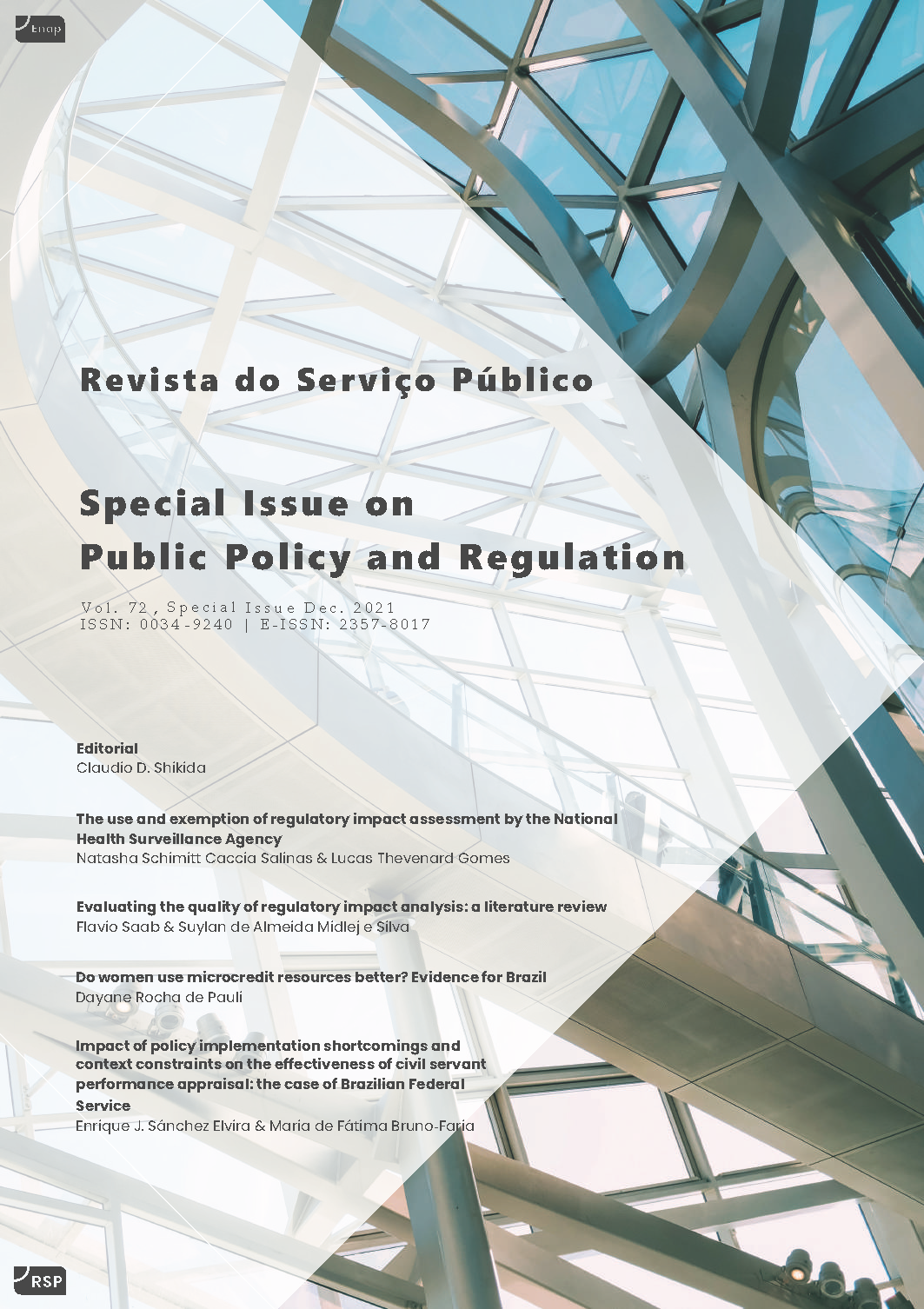Evaluating the quality of Regulatory Impact Analysis
a literature review
Palabras clave:
regulatory impact analysis, RIA, regulation, qualityResumen
Regulatory Impact Analysis (RIA) is an instrument that can provide information and knowledge to decision makers to assess whether a given regulation is capable of achieving its objectives, with acceptable impacts and reasonable costs. For RIA to be useful and guide good decisions, it is not enough that it is carried out; it needs to be of quality. This research aimed to understand the current stage of the literature on RIA quality evaluation and offer practical and theoretical contributions, as well as an agenda for future studies. Through literature review, 26 empirical articles were identified and examined. A decreasing pace of publications and the use of various dimensions and methods for evaluating the quality of RIA were identified. It was found that the RIAs performed in the last 40 years have shown important weaknesses and inconsistencies that can compromise their use. In order to advance the knowledge on the topic, new studies that evaluate the quality of the RIA in different countries and regions, with a critical approach to the methods used, and that identify political and institutional factors related to analyses of higher or lower quality were suggested.
Descargas
Citas
Achtnicht, M., Rennings, K., & Hertin, J. (2009). Experiences with integrated impact assessment - Empirical evidence from a survey in three European member states. Environmental Policy and Governance, 19(5), 321–335. https://doi.org/10.1002/eet.517
Adelle, C., & Jordan, A. (2014). Policy Coherence for Development in the European Union: Do New Procedures Unblock or Simply Reproduce Old Disagreements? Journal of European Integration, 36(4), 375–391. https://doi.org/10.1080/07036337.2013.845180
Adelle, C., Weiland, S., Dick, J., González Olivo, D., Marquardt, J., Rots, G., Wübbeke, J., & Zasada, I. (2016). Regulatory impact assessment: a survey of selected developing and emerging economies. Public Money and Management, 36(2), 89–96. https://doi.org/10.1080/09540962.2016.1118930
Bailey, P. D., Haq, G., & Gouldson, A. (2002). Mind the gap! Comparing ex ante and ex post assessments of the costs of complying with environmental regulation. European Environment, 12(5), 245–256. https://doi.org/10.1002/eet.303
Ballantine, B., & Devonald, B. (2006). Modern regulatory impact analysis: The experience of the European Union. Regulatory Toxicology and Pharmacology, 44(1), 57–68. https://doi.org/10.1016/j.yrtph.2005.06.016
Belcore, J., & Ellig, J. (2008). Homeland security and regulatory analysis: are we safe yet? Rutgers Law Journal, 40(01).
Belfield, C. R., Bowden, A. B., & Rodriguez, V. (2018). Evaluating Regulatory Impact Assessments in Education Policy. American Journal of Evaluation. https://doi.org/10.1177/1098214018785463
Bull, R., & Ellig, J. (2017). Judicial Review of Regulatory Impact Analysis: Why Not The Best? ABA Journal, 69(FEB4), 725–840.
Carroll, P. (2010). Does regulatory impact assessment lead to better policy? Policy and Society, 29(2), 113–122. https://doi.org/10.1016/j.polsoc.2010.03.009
Castro, C. M. de. (2014). Some aspects of implementing Regulatory Impact Analysis in Brazil. Revista de Administração Pública, 48(2), 323–342. https://doi.org/10.1590/0034-76121359
Cecot, C., Hahn, R. W., & Renda, A. (2007). A Statistical Analysis of the Quality of Impact Assessment in the European Union. Social Science Research, May.
Daskal, S., Ayalon, O., & Shechter, M. (2019). Closing the Loop: the Challenges of Regulation in Municipal Solid Waste Management. Detritus, In Press(0), 1. https://doi.org/10.31025/2611-4135/2019.13775
de Francesco, F. (2012). Diffusion of Regulatory Impact Analysis Among OECD and EU Member States. Comparative Political Studies, 45(10), 1277–1305. https://doi.org/10.1177/0010414011434297
Dudley, S., Belzer, R., Blomquist, G., Brennan, T., Carrigan, C., Cordes, J., Cox, L. A., Fraas, A., Graham, J., Gray, G., Hammitt, J., Krutilla, K., Linquiti, P., Lutter, R., Mannix, B., Shapiro, S., Smith, A., Viscusi, W. K., & Zerbe, R. (2017). Consumer’s Guide to Regulatory Impact Analysis: Ten Tips for Being an Informed Policymaker. Journal of Benefit-Cost Analysis, 8(2),187–204. https://doi.org/10.1017/bca.2017.11
Ellig, J. (2018). Why and how independent agencies should conduct regulatory impact analysis. Cornell Journal of Law and Public Policy, 28(1),1–34. https://doi.org/10.2139/ssrn.3169413
Ellig, J., & Conover, C. J. (2014). Presidential priorities, congressional control, and the quality of regulatory analysis: an application to healthcare and homeland security. Public Choice, 161(3–4), 305–320. https://doi.org/10.1007/s11127-014-0201-3
Ellig, J., & Fike, R. (2016). Regulatory Process, Regulatory Reform, and the Quality of Regulatory Impact Analysis. Journal of Benefit-Cost Analysis, 7(3), 523–559. https://doi.org/10.1017/bca.2016.20
Ellig, J., & Horney, M. (2019). Statutory delegation, agency authority, and the asymmetry of impact analysis. Theory and Practice of Legislation, 7(3), 227–256. https://doi.org/10.1080/20508840.2020.1730097
Ellig, J., & Mclaughlin, P. A. (2012). The Quality and Use of Regulatory Analysis in 2008. Risk Analysis, 32(5), 855–880. https://doi.org/10.1111/j.1539-6924.2011.01715.x
Ellig, J., Mclaughlin, P. A., & Morrall, J. F. (2013). Continuity, change, and priorities: The quality and use of regulatory analysis across US administrations. Regulation and Governance, 7(2), 153–173. https://doi.org/10.1111/j.1748-5991.2012.01149.x
Fraas, Art, & Lutter, R. (2011). The challenges of improving the economic analysis of pending regulations: The experience of OMB circular A-4. Annual Review of Resource Economics, 3(December),71–85. https://doi.org/10.1146/annurev-resource-083110-120042
Fraas, Arthur. (1991). The Role of Economic Analysis in Shaping Environmental Policy. Law and Contemporary Problems, 113–126. https://doi.org/10.1007/978-1-349-04722-2_5
Fritsch, O., Kamkhaji, J. C., & Radaelli, C. M. (2017). Explaining the content of impact assessment in the United Kingdom: Learning across time, sectors, and departments. Regulation and Governance, 11(4), 325–342. https://doi.org/10.1111/rego.12129
Fritsch, O., Radaelli, C. M., Schrefler, L., & Renda, A. (2013). Comparing the content of regulatory impact assessments in the UK and the EU. Public Money and Management, 33(6), 445–452. https://doi.org/10.1080/09540962.2013.836007
Goodstein, E. (1995). Benefit-cost analysis at the EPA. Journal of Socio-Economics, 24(2), 375–389. https://doi.org/10.1016/1053-5357(95)90026-8
Hahn, R. W., Burnett, J. K., Chan, Y. H. I., & Mader, E. A. (2000). Assessing regulatory impact analyses: The failure of agencies to comply with executive order 12,866. Harvard Journal of Law and Public Policy.
Hahn, R. W., & Dudley, P. M. (2004). How Well Does the Government Do Cost-Benefit Analysis? SSRN Electronic Journal. https://doi.org/10.2139/ssrn.495462
Hahn, R. W., & Tetlock, P. C. (2008). Has Economic Analysis Improved Regulatory Decisions? Journal Of Economic Perspectives, 22(1), 67–84.
Hansson, L., & Nerhagen, L. (2019). Regulatory measurements in policy coordinated practices: The case of promoting renewable energy and cleaner transport in Sweden. Sustainability (Switzerland), 11(6). https://doi.org/10.3390/su11061687
Harrington, W. (2006). Grading Estimates of the Benefits and Costs of Federal Regulation. Resources for The Future. https://doi.org/10.2139/ssrn.937357
Harrington, W., Morgenstern, R. D., & Nelson, P. (2000). On the accuracy of regulatory cost estimates. Journal of Policy Analysis and Management, 19(2), 297–322. https://doi.org/10.1002/(sici)1520-6688(200021)19:2<297::aid-pam7>3.3.co;2-o
Humpherson, E. (2004). The National Audit Office’s evaluation of RIAs: Reflections on the pilot year. Public Money and Management, 24(5), 277–282. https://doi.org/10.1111/j.1467-9302.2004.00434.x
Jacobs, S. (2004). Regulatory impact assessment and the economic transition to markets. Public Money and Management, 24(5), 283–290. https://doi.org/10.1111/j.1467-9302.2004.00435.x
Jarrar, A. G. (2018). Regulatory Impact Assessment Role in Developing Participatory Work between Civil Society Organizations and Jordanian Ministry of Political and Parliamentary Affairs. Journal of Politics and Law, 11(1), 88. https://doi.org/10.5539/jpl.v11n1p88
Kirkpatrick, C., Parker, D., & Zhang, Y. F. (2004). Regulatory impact assessment in developing and transition economies: A survey of current practice. Public Money and Management, 24(5), 291–296. https://doi.org/10.1111/j.1467-9302.2004.00436.x
Letens, G., Van Nuffel, L., Heene, A., & Leysen, J. (2008). Towards a balanced approach in risk identification. EMJ - Engineering Management Journal, 20(3), 3–9. https://doi.org/10.1080/10429247.2008.11431771
Lussis, B. (2004). EU extended impact assessment review. Institut Pour Un Développement Durable.
Meneguin, F. B., & Saab, F. (2020). Análise de Impacto Regulatório: Perspectivas a partir da Lei da Liberdade Econômica. Textos Para Discussão, Senado, 271.
Mota, D., Saab, F., Vazzoler, R., Schunig, K., Donagema, E., & Troncoso, G. (2020). Regulatory Impact Assessment in Pandemic Times: a practical exercise on the COVID-19 context. 71, 165–188. http://dx.doi.org/xx.xxxxx/rsp.xxxx
Nweke, O. C. (2011). A framework for integrating environmental justice in regulatory analysis. International Journal of Environmental Research and Public Health, 8(6), 2366–28385. https://doi.org/10.3390/ijerph8062366
OECD. (2019). Indicators of Regulatory Policy and Governance, Latin America 2019, El Salvador. http://oe.cd/ireg-lac
Opoku, C., & Jordan, A. (2004). Impact assessment in the EU: a global sustainable development perspective. Conference on the Human Dimension of Global Environmental Change, December. http://userpage.fu-berlin.de/ffu/akumwelt/bc2004/download/opoku_jordan_f.pdf
Peci, A., & Sobral, F. (2011). Regulatory Impact Assessment: How political and organizational forces influence its diffusion in a developing country. Regulation and Governance, 5(2), 204–220. https://doi.org/10.1111/j.1748-5991.2011.01105.x
Posner, E. A. (2003). Transfer regulations and cost-effectiveness analysis. Duke Law Journal, 53(3), 1067–1110.
Radaelli, C. M. (2004a). Getting to grips with quality in the diffusion of regulatory impact assessment in Europe. Public Money and Management, 24(5), 271–276. https://doi.org/10.1111/j.1467-9302.2004.00433.x
Radaelli, C. M. (2004b). The diffusion of regulatory impact analysis - Best practice or lesson-drawing? European Journal of Political Research, 43(5), 723–747. https://doi.org/10.1111/j.0304-4130.2004.00172.x
Radaelli, C. M. (2005). Diffusion without convergence: How political context shapes the adoption of regulatory impact assessment. Journal of European Public Policy, 12(5), 924–943. https://doi.org/10.1080/13501760500161621
Radaelli, C. M. (2010). Rationality, Power, Management and Symbols: Four Images of Regulatory Impact Assessment. Scandinavian Political Studies, 33(2), 164–188. https://doi.org/10.1111/j.1467-9477.2009.00245.x
Radchenko, T., & Parshina, E. (2014). Regulatory Impact Assessment in Russia: Application and Lessons from Economic Theory. Economic Policy.
Renda, A. (2006). Impact Assessment in the UE. The State of the Art and the Art of the State.
Reyes, R., Romano, A., & Sottilotta, C. E. (2015). Regulatory Impact Assessment in Mexico: A Story of Interest Groups Pressure. Law and Development Review, 8(1), 99–121. https://doi.org/10.1515/ldr-2014-0030
Rissi, C., & Sager, F. (2013). Types of knowledge utilization of regulatory impact assessments: Evidence from Swiss policymaking. Regulation and Governance, 7(3), 348–364. https://doi.org/10.1111/rego.12002
Robinson, L. A., & Levy, J. I. (2011). The [R]Evolving Relationship Between Risk Assessment and Risk Management. Risk Analysis, 31(9), 1334–1344. https://doi.org/10.1111/j.1539-6924.2011.01653.x
Russel, D., & Turnpenny, J. (2009). The politics of sustainable development in UK government: What role for integrated policy appraisal? Environment and Planning C: Government and Policy, 27(2), 340–354. https://doi.org/10.1068/c0810j
Saab, F., Bermejo, P. H. de S., Garcia, G. C., Pereira, J. S., & e Silva, S. de A. M. (2018). Does public consultation encourage social participation? Journal of Enterprise Information Management, JEIM-11-2017-0169. https://doi.org/10.1108/JEIM-11-2017-0169
Shapiro, S., & Morrall, J. F. (2012). The triumph of regulatory politics: Benefit-cost analysis and political salience. Regulation and Governance, 6(2), 189–206. https://doi.org/10.1111/j.1748-5991.2012.01131.x
Silva, A. B., Godoi, C. K., & Bandeira-de-Mello, R. (2006). Pesquisa qualitativa em estudos organizacionais: paradigmas, estratégias e métodos, São Paulo, Ed. Saraiva.
Souto-Otero, M. (2013). Is “better regulation” possible? Formal and substantive quality in the impact assessments in education and culture of the European Commission. Evidence and Policy, 9(4), 513–529. https://doi.org/10.1332/174426413X662725
Staronova, K. (2016). Regulatory impact assessment in Slovakia: performance and procedural reform. Impact Assessment and Project Appraisal, 34(3), 214–227. https://doi.org/10.1080/14615517.2016.1176410
Staroňová, K. (2009). Better regulation and regulatory quality: The case of RIA in Slovakia. Sociologia, 41(3), 247–264.
Staroňová, K. (2010). Regulatory impact assessment: Formal institutionalization and practice. Journal of Public Policy, 30(1), 117–136. https://doi.org/10.1017/S0143814X09990201
Staroňová, K., Pavel, J., & Krapež, K. (2007). Piloting regulatory impact assessment: A comparative analysis of the Czech Republic, Slovakia and Slovenia. Impact Assessment and Project Appraisal, 25(4), 271–280. https://doi.org/10.3152/146155107X246314
Vibert, F. (2006). The limits of regulatory reform in the EU. Economic Affairs, 26(2), 17–21. https://doi.org/10.1111/j.1468-0270.2006.00626.x
Vinuto, J. (2014). a Amostragem Em Bola De Neve Na Pesquisa Qualitativa: Um Debate Em Aberto. Temáticas, 22(44), 203–220. https://doi.org/10.20396/tem
Zentner, R. D. (1984). Chemical Industry Perspectives on Regulatory Impact Analysis. 161–173. https://doi.org/10.1021/bk-1984-0239.ch011
Descargas
Publicado
Cómo citar
Número
Sección
Licencia
Derechos de autor 2021 Revista do Serviço Público

Esta obra está bajo una licencia internacional Creative Commons Atribución-NoComercial-CompartirIgual 4.0.
- A RSP adota a licença Creative Commons (CC) do tipo Atribuição – Uso Não-Comercial (BY-NC).
- A licença permite que outros remixem, adaptem e criem obra licenciada, sendo proibido o uso com fins comerciais.
- As novas obras devem fazer referência ao autor nos créditos e não podem ser usadas com fins comerciais, porém não precisam ser licenciadas sob os mesmos termos dessa licença.
- Ao publicar o artigo na RSP, o autor cede e transfere para a ENAP os direitos autorais patrimoniais referentes ao artigo.
- O artigo publicado na RSP não poderá ser divulgado em outro meio sem a devida referência à publicação de origem.
- O autor que tiver o artigo publicado na RSP deverá assinar o Termo de Concessão de Direitos Autorais (em momento oportuno a editoria da Revista entrará em contato com o autor para assinatura do Termo).



